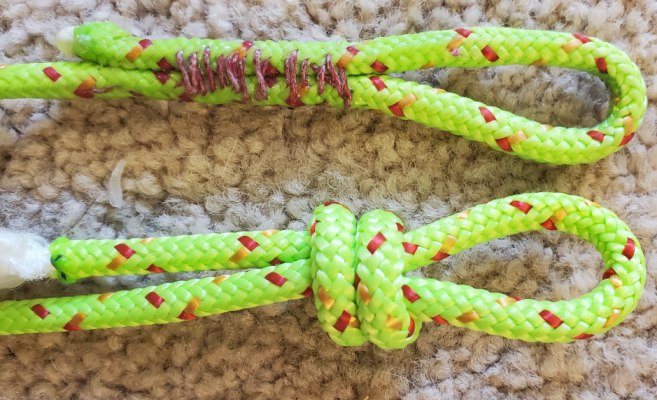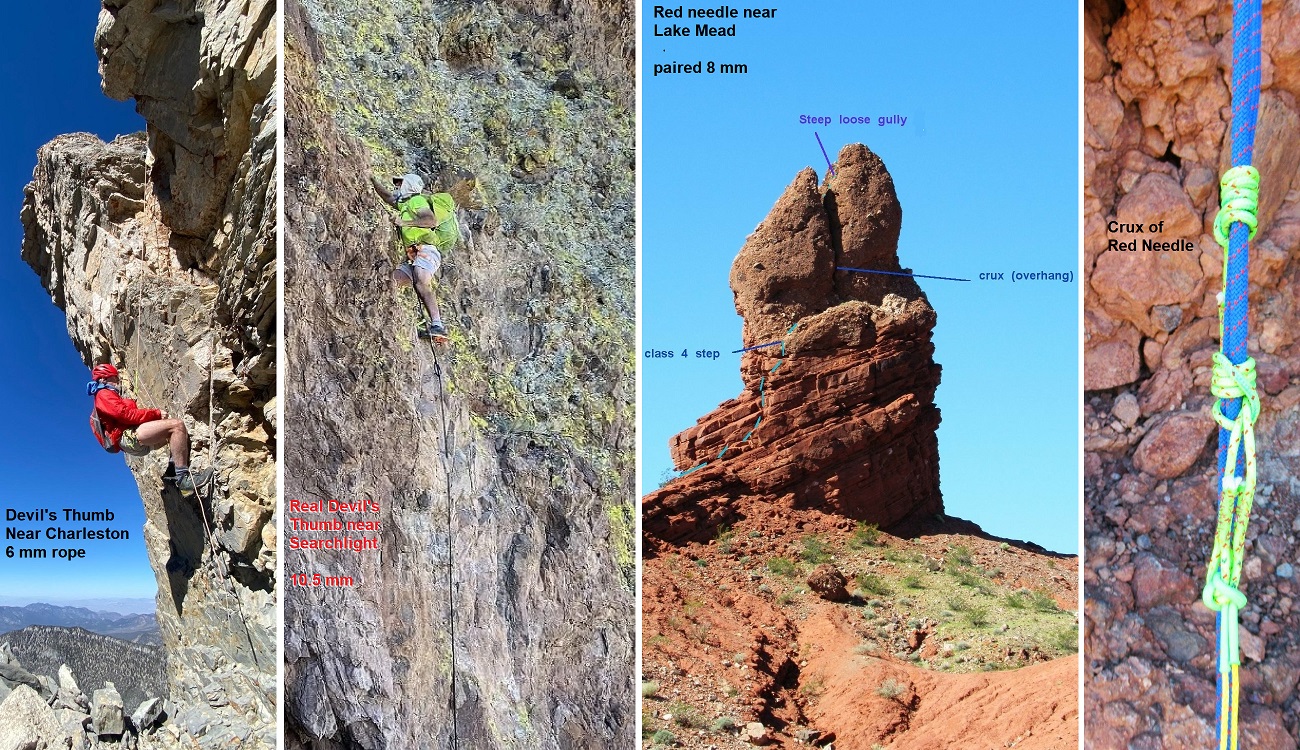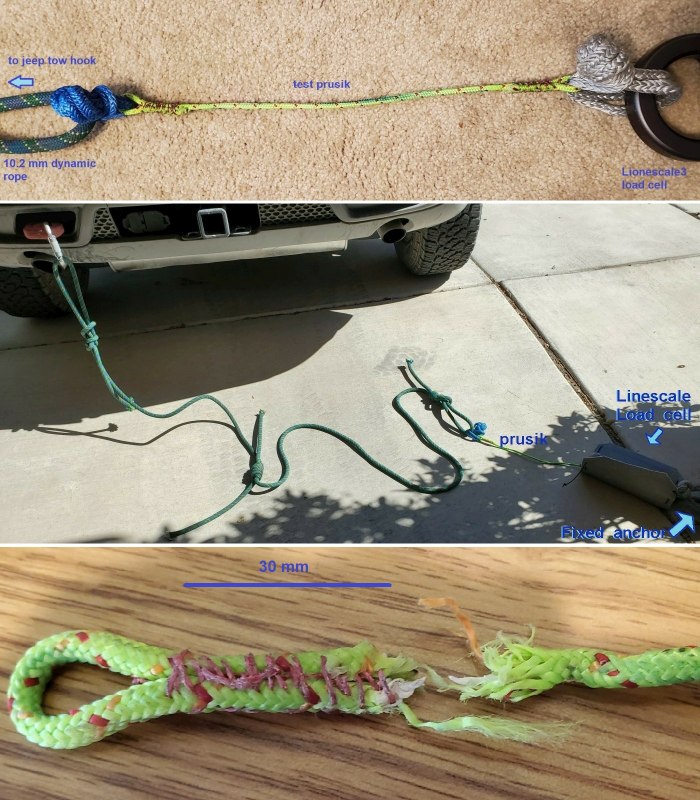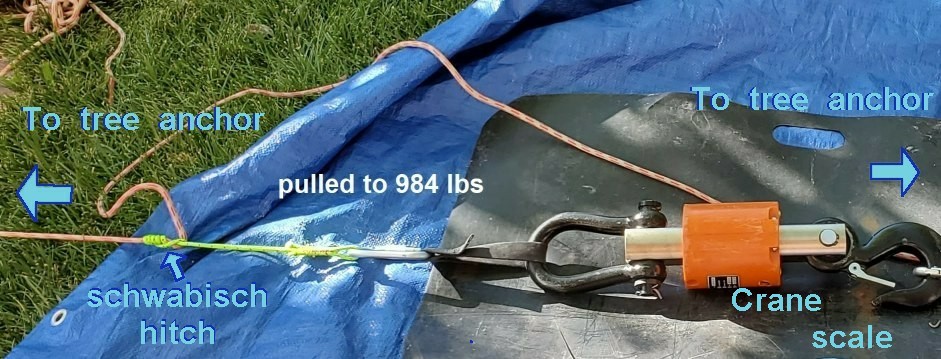Breaking hand-sewn “4 mm” eye-to-eye prusiks (polyester-covered Dyneema). Bottom line: very strong.
WARNING: I discuss sewing rope! SEWING ROPE IS VERY DANGEROUS! IF YOU
SEW ROPE, YOU WILL DIE EVENTUALLY! READ THIS FOR CURIOSITY ONLY!
Where are eye-to-eye prusiks used?
They are used to tie asymmetrical friction hitches, to ascend vertical (or high-angle) ropes.
Asymmetrical hitches cannot be tied from a closed prusik loop. I use
friction hitches to ascend rope (often 6mm or smaller Dyneema-core
rope). I prefer friction hitches to mechanical ascenders, for several
reasons. First, friction hitches can be used on small diameter ropes,
provided one has strong cord; the only mechanical ascenders I’ve found
that work on 6mm rope are rope-clamp-like devices, such as the Kong
Duck (which is a bit scary). Second, friction hitches are easily used
on double ropes; again some rope clamps will work on double thin ropes,
but the use is a bit scary. Third, friction hitches can be very light.
I use asymmetrical hitches, like the scwhabisch knot, because they are
easier to move after they are weighted, compared to the familiar prusik
and klemheist knots. With a bit of thought and care, they can be used
without carabiners (except at the harness).
Commercially available (sewn) eye-to-eye prusiks are generally burly
affairs, with 8mm rope as a minimum, and must be fairly long to
accommodate large “knots.” They are mainly used by arborists who are
generally unconcerned about counting ounces, and they don’t work on
very thin ropes. In most home-made eye-to-eye prusiks, the eyes
are
made with double fisherman’s slip-knots on each end. My own testing
shows the slip knots to be fairly strong; about 70% of the native cord
strength, when pulled to breakung on carabiners. But these “eyes” can
be hard to remove from the carabiners after they are weighted, and are
rather cumbersome when one is trying to feed the ends of the rope
through bights, as the scwhabisch is being tied. (Below, slip knot vs.
sewn eye.)

I prefer to sew eyes on the ends of the prusik, by hand. I use 5/32”
spyderline which has a strong polyester sheath on a Dyneema core, with a
reported breaking strength of 1860 lbs. (5/32" is actually closer to
6/32”.) The resulting eye-to-eye kit is very small and compact, and
quite versatile; I’ve used it to ascend “ropes” from 5 to 10.5 mm in
diameter, and doubled 8mm ropes, e.g. here (click for larger image):

I sew rope all the time; I wouldn’t do it if I did not also do pull and
break tests. I know what I am doing, how to estimate the number of
stitches for a certain strength, and I use 100 lb Spectra braided
fishing line as “thread.” I have discussed sewing techniques in the
previous discussion of sewn Titan tech cord.
Roughly, the number of stitches, N, one needs to achieve TotStrength is
N =TotStrength / (0.7*ThreadStrength).
Typically you want TotStrength to be at least 2x the rope breaking strength.
I made this prusik in my urethane-crazy days, and urethane-saturated
the rope below the sewing—where the prusik eventually broke. My current
strategy is to use urethane on the exposed parts and stitching only,
and I no longer try to work the urethane into the rope. There is vague
evidence that the urethane slightly weakens saturated rope, not because
of a chemical reaction, but because the fibers rub against each other
with more friction and less chance to accommodate stretching of individual yarns .
The tests
The setup is shown below (click for larger image).Once again, the force was supplied by my Jeep over a second or two,
with a dynamic rope acting as a buffer. The prusik broke at 1604 lbs,
or 86.2% of the rope rating. This was pulled end-to-end, so the
strength of both strands in a typical hitch would be ~3200 lbs, with both eyes weighted. There
are other constraints on how much a friction hitch will hold, which we
will discuss momentarily.

The bottom shows the prusik broke just below one sewn eye; the prusik
is pulled asymmetrically at the bottom of the stitching, and the
urethane saturation may have weakened the rope slightly. And the sun
was in my eyes. But 86.2% of advertised breaking strength is not bad,
considering that this was a quick pull over about 2 seconds.
As hinted, the strength of the eye-to-eye prusik is somewhat
irrelevant, if the friction hitch slips. Below shows a test
pulling a schwabisch hitch tied in the green 4 mm eye-to-eye prusik;
the hitch is tied on my 6 mm (white-red) 4900 lb bs rope. I used a
comealong to bring
the system to 984 lbs, and the hitch did not slip. Yet the hitch was
fairly easy to
move, once unweighted.

AND REMEMBER, SEWING ROPES IS VERY DANGEROUS!



